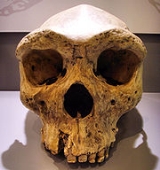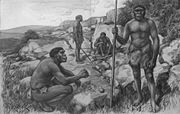
Rhodesian Man
Encyclopedia
Kabwe skull or Kabwe cranium, or Broken Hill 1 is a hominin fossil that was frequently classified as belonging to Homo rhodesiensis
. The cranium was found in an lead
and zinc
mine in Broken Hill, Northern Rhodesia
(now Kabwe
, Zambia
) in 1921 by Tom Zwiglaar, a Swiss miner
. In addition to the cranium, an upper jaw
from another individual, a sacrum
, a tibia
, and two femur
fragments were also found. The skull was dubbed Rhodesian Man at the time of the find, but is now commonly referred to as the Broken Hill Skull or the Kabwe Cranium.
.jpg)
 The association between the bones is unclear, but the tibia and femur fossils are usually associated with the skull. Rhodesian Man is dated to be between 125,000 and 300,000 years old. Cranial capacity of the Broken Hill skull has been estimated at 1,100 cm³, which, when coupled with the more recent dating, makes any direct link to older skulls unlikely and negates the 1.75 to 2.5 million year earlier erroneous dating. Bada & al (1974) published direct date of 110 ka for this specimen measured by aspartic acid
The association between the bones is unclear, but the tibia and femur fossils are usually associated with the skull. Rhodesian Man is dated to be between 125,000 and 300,000 years old. Cranial capacity of the Broken Hill skull has been estimated at 1,100 cm³, which, when coupled with the more recent dating, makes any direct link to older skulls unlikely and negates the 1.75 to 2.5 million year earlier erroneous dating. Bada & al (1974) published direct date of 110 ka for this specimen measured by aspartic acid
racemisation. The destruction of the paleoanthropological site has made layered dating impossible.
The skull is from an extremely robust individual, and has the comparatively largest brow-ridges of any known hominid remains. It was described as having a broad face similar to Homo neanderthalensis
(i.e. large nose and thick protruding brow ridges), and has been interpreted as an "African Neanderthal". However, when regarding the skulls extreme robustness, recent research has pointed to several features intermediate between modern Homo sapiens and Neanderthal. Most current experts believe Rhodesian Man to be within the group of Homo heidelbergensis
though other designations such as Archaic Homo sapiens and Homo sapiens rhodesiensis have also been proposed. According to Tim White, it is probable that Rhodesian Man was the ancestor of Homo sapiens idaltu
(Herto Man), which would be itself at the origin of Homo sapiens sapiens. No direct linkage of the species can so far be determined.
The skull has cavities in ten of the upper teeth and is considered the oldest occurrence of cavities for a hominid. Pitting indicates significant infection before death and implies a cause of death attributable to dental infection or chronic ear infection.
Homo rhodesiensis
Homo rhodesiensis is a hominin species described from the fossil Kabwe skull. Other morphologically-comparable remains have been found from the same, or earlier, time period in southern Africa , East Africa and North Africa...
. The cranium was found in an lead
Lead
Lead is a main-group element in the carbon group with the symbol Pb and atomic number 82. Lead is a soft, malleable poor metal. It is also counted as one of the heavy metals. Metallic lead has a bluish-white color after being freshly cut, but it soon tarnishes to a dull grayish color when exposed...
and zinc
Zinc
Zinc , or spelter , is a metallic chemical element; it has the symbol Zn and atomic number 30. It is the first element in group 12 of the periodic table. Zinc is, in some respects, chemically similar to magnesium, because its ion is of similar size and its only common oxidation state is +2...
mine in Broken Hill, Northern Rhodesia
Northern Rhodesia
Northern Rhodesia was a territory in south central Africa, formed in 1911. It became independent in 1964 as Zambia.It was initially administered under charter by the British South Africa Company and formed by it in 1911 by amalgamating North-Western Rhodesia and North-Eastern Rhodesia...
(now Kabwe
Kabwe
Kabwe is the capital of the Zambian Central Province with a population estimated at 210,000. Formerly named Broken Hill, it was founded when the Broken Hill lead and zinc deposits were discovered in 1902. Kabwe also has a claim to being the birthplace of Zambian politics...
, Zambia
Zambia
Zambia , officially the Republic of Zambia, is a landlocked country in Southern Africa. The neighbouring countries are the Democratic Republic of the Congo to the north, Tanzania to the north-east, Malawi to the east, Mozambique, Zimbabwe, Botswana and Namibia to the south, and Angola to the west....
) in 1921 by Tom Zwiglaar, a Swiss miner
Mining
Mining is the extraction of valuable minerals or other geological materials from the earth, from an ore body, vein or seam. The term also includes the removal of soil. Materials recovered by mining include base metals, precious metals, iron, uranium, coal, diamonds, limestone, oil shale, rock...
. In addition to the cranium, an upper jaw
Jaw
The jaw is any opposable articulated structure at the entrance of the mouth, typically used for grasping and manipulating food. The term jaws is also broadly applied to the whole of the structures constituting the vault of the mouth and serving to open and close it and is part of the body plan of...
from another individual, a sacrum
Sacrum
In vertebrate anatomy the sacrum is a large, triangular bone at the base of the spine and at the upper and back part of the pelvic cavity, where it is inserted like a wedge between the two hip bones. Its upper part connects with the last lumbar vertebra, and bottom part with the coccyx...
, a tibia
Tibia
The tibia , shinbone, or shankbone is the larger and stronger of the two bones in the leg below the knee in vertebrates , and connects the knee with the ankle bones....
, and two femur
Femur
The femur , or thigh bone, is the most proximal bone of the leg in tetrapod vertebrates capable of walking or jumping, such as most land mammals, birds, many reptiles such as lizards, and amphibians such as frogs. In vertebrates with four legs such as dogs and horses, the femur is found only in...
fragments were also found. The skull was dubbed Rhodesian Man at the time of the find, but is now commonly referred to as the Broken Hill Skull or the Kabwe Cranium.
.jpg)

Aspartic acid
Aspartic acid is an α-amino acid with the chemical formula HOOCCHCH2COOH. The carboxylate anion, salt, or ester of aspartic acid is known as aspartate. The L-isomer of aspartate is one of the 20 proteinogenic amino acids, i.e., the building blocks of proteins...
racemisation. The destruction of the paleoanthropological site has made layered dating impossible.
The skull is from an extremely robust individual, and has the comparatively largest brow-ridges of any known hominid remains. It was described as having a broad face similar to Homo neanderthalensis
Neanderthal
The Neanderthal is an extinct member of the Homo genus known from Pleistocene specimens found in Europe and parts of western and central Asia...
(i.e. large nose and thick protruding brow ridges), and has been interpreted as an "African Neanderthal". However, when regarding the skulls extreme robustness, recent research has pointed to several features intermediate between modern Homo sapiens and Neanderthal. Most current experts believe Rhodesian Man to be within the group of Homo heidelbergensis
Homo heidelbergensis
Homo heidelbergensis is an extinct species of the genus Homo which may be the direct ancestor of both Homo neanderthalensis in Europe and Homo sapiens. The best evidence found for these hominins date between 600,000 and 400,000 years ago. H...
though other designations such as Archaic Homo sapiens and Homo sapiens rhodesiensis have also been proposed. According to Tim White, it is probable that Rhodesian Man was the ancestor of Homo sapiens idaltu
Homo sapiens idaltu
Homo sapiens idaltu is an extinct subspecies of Homo sapiens that lived almost 160,000 years ago in Pleistocene Africa. is from the Saho-Afar word meaning "elder or first born"....
(Herto Man), which would be itself at the origin of Homo sapiens sapiens. No direct linkage of the species can so far be determined.
The skull has cavities in ten of the upper teeth and is considered the oldest occurrence of cavities for a hominid. Pitting indicates significant infection before death and implies a cause of death attributable to dental infection or chronic ear infection.
See also
- List of fossil sites (with link directory)
- List of hominina (hominid) fossils (with images)

